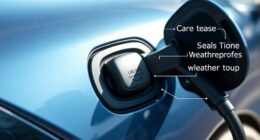If your heater blows cold air, start by checking the blend door and its actuator, which control hot and cold airflow. Listen for clicking sounds that may indicate a faulty motor or inspect for stuck or broken doors. Also, examine the heater core for blockages or leaks; a clogged core prevents proper heat transfer. Ensuring your coolant level is adequate is essential, as low coolant can also cause cold airflow. Keep exploring to find detailed troubleshooting steps.
Key Takeaways
- Listen for clicking noises under the dashboard to identify a faulty or stuck blend door actuator.
- Check the coolant level and inspect for leaks to ensure proper heater core operation.
- Feel the heater hoses; cold hoses indicate a clogged or failing heater core.
- Manually move the blend door or observe its movement if accessible to verify actuator function.
- Confirm electrical connections and test the actuator for proper operation to rule out electronic or motor failure.

Have you ever turned on your heater expecting warmth only to be greeted by cold air? It’s frustrating, especially when you’re counting on your vehicle to keep you comfortable during chilly days. This problem often points to issues with the blend door or heater core, two key components in your heating system. Understanding what these parts do and how they can cause cold air to blow can help you diagnose and fix the problem more efficiently.
First, consider the blend door. Think of it as a gatekeeper that controls whether hot air from the heater core or cold outside air gets into your cabin. When you turn up the heat, the blend door swings into position to direct warm air into the vents. If it gets stuck or malfunctions, it might stay closed, preventing hot air from reaching your interior even if your heater is working fine.
The blend door controls whether hot or cold air enters your cabin, and a malfunction can block warm airflow.
This can happen due to a broken blend door actuator, which is the motor responsible for moving the door. If the actuator fails or the linkage is disconnected, you’ll get cold air no matter what temperature setting you choose. Sometimes, you might hear clicking or strange noises from under the dashboard, signaling that the actuator isn’t functioning properly.
Diagnosing this issue involves checking for electrical problems, listening for actuator sounds, or manually inspecting the door’s movement if accessible.
Next, the heater core itself can be the culprit. Think of it as a small radiator that heats your car’s interior using hot engine coolant. If the heater core becomes clogged with debris or scale, it won’t transfer heat effectively.
This blockage prevents hot coolant from circulating properly, leading to cold air blowing through your vents. Sometimes, you might notice a sweet smell inside the car or see foggy windows—signs that the heater core might be leaking or not functioning correctly. Flushing the heater core can sometimes resolve minor blockages, but in severe cases, replacement might be necessary.
Making sure that your engine’s coolant level is adequate is also vital because low coolant can cause poor heater performance. Additionally, modern heating systems often include electronic controls that can malfunction, further complicating diagnosis.
In many cases, both the blend door and heater core issues can contribute to cold air blowing from your heater. Start by checking the coolant level and looking for leaks or other engine cooling system problems.
If the coolant is fine, then focus on the blend door and actuator. Sometimes, fixing these components requires removing parts of the dashboard or accessing internal mechanisms, so don’t hesitate to seek professional help if you’re uncomfortable with complicated repairs.
Addressing these issues promptly guarantees you’ll get back to enjoying a warm, cozy ride rather than shivering in your seat.
Frequently Asked Questions
How Can I Temporarily Fix a Heater Blowing Cold Air?
If your heater blows cold air, try temporarily fixing it by checking the coolant level and topping it off if needed.
Turn the heater controls to the hot setting and ensure the temperature dial is fully turned up.
You can also gently tap or wiggle the blend door actuator to see if it’s stuck.
These quick fixes may improve warmth temporarily, but a professional inspection is advised for a lasting fix.
What Are Signs My Blend Door Motor Is Failing?
A stitch in time saves nine, so watch for signs your blend door motor is failing. You might notice inconsistent airflow, strange noises like clicking or knocking when adjusting the climate control, or the air temperature won’t change despite your settings.
Sometimes, the blend door gets stuck, or you hear a grinding sound. If these occur, it’s a clear sign you need to inspect or replace the blend door motor to avoid further issues.
Can Low Coolant Cause Heater Issues?
Yes, low coolant can cause heater issues. When your coolant level drops, the heater core doesn’t receive enough hot fluid to warm the air passing through it. This results in cooler or cold airflow inside your vehicle.
To fix this, you should check your coolant level and top it off if needed. If the problem persists, inspect for leaks or other cooling system issues, as low coolant often signals underlying problems.
How Long Does a Heater Core Replacement Take?
Think of replacing your heater core as unwinding a complex puzzle—it typically takes about 4 to 8 hours, depending on your vehicle’s make and model.
You’ll need patience and a bit of mechanical skill, as the process involves draining coolant, removing dashboard components, and installing the new core.
Preparing for a full day guarantees you won’t rush, and your heating system will work like new.
Is It Safe to Drive With a Heater Problem?
Driving with a heater problem isn’t inherently unsafe, but it can be uncomfortable and potentially risky in cold weather. If your heater isn’t working properly, you might struggle with visibility due to fogged windows or reduced defrosting.
It’s best to get the issue checked promptly to guarantee your vehicle’s heating and defrosting systems work correctly, keeping you safe and comfortable on the road.
Conclusion
If your heater blows cold, checking the blend door and heater core can save you time and money. Remember, a properly functioning heating system keeps you comfortable and safe during winter months. notably, studies show that over 60% of vehicle breakdowns in winter are caused by heating system issues, emphasizing the importance of timely diagnostics. Don’t ignore those cold blasts—address the problem early to stay warm and avoid costly repairs later.









